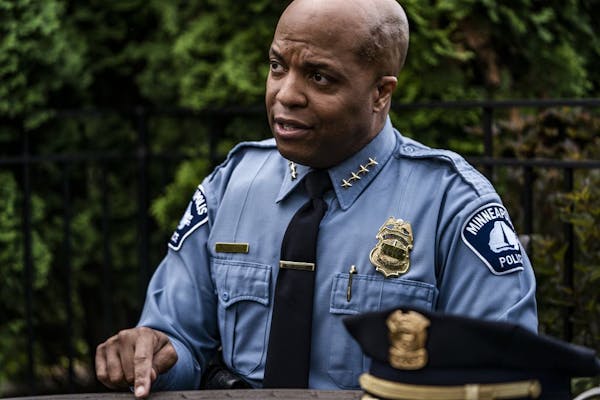A Star Tribune/MPR News/KARE 11 Minnesota Poll released this week offered a glimpse of how Minneapolis voters view their police department, Mayor Jacob Frey, the City Council and several proposed changes to policing in the city following the May 25 killing of George Floyd. Let's take a deeper dive into some of the poll's findings.
First, to review: 800 registered Minneapolis voters were interviewed between Aug. 10 and Aug. 12. That sample included interviews with 525 self-identified white registered voters and 146 Black registered voters. An additional 354 interviews were conducted Aug. 6 to Aug. 12 with Black registered voters in Minneapolis, for a total of 500 interviews. This is commonly referred to as an "oversample," and it allowed for an apples-to-apples comparison of the responses of white voters and Black voters. The margin of error for the sample of 800 registered voters was ± 3.5 percentage points, while the margin of error for the samples of white and Black voters was no more than ± 4.5 percentage points. Margins of error for any subgroups within the sample will be higher, so it is best to speak in broad strokes.
Here are five key takeaways from the poll.
1. Minneapolis Mayor Jacob Frey remains relatively popular
The first-term mayor drew sharp criticism after Floyd's killing and in the ensuing days of protests and rioting that damaged swaths of the city. But Frey appears to have emerged in decent political shape, with 50% of voters saying they have a favorable view of the mayor, compared with 27% unfavorable. Frey's standing was even stronger among Black voters, 60% of whom said they hold a favorable view of him and 13% unfavorable.
The poll found a significant age gap between how younger and older voters view the mayor. The chart below shows Frey's net favorability rating (the percentage that said they had a favorable view minus the percentage that said unfavorable) for each age demographic.
While the poll found Frey is viewed more positively than the Minneapolis City Council — 43% had a favorable view of the council vs. 33% unfavorable — a larger share of voters said they trust the council more than Frey to make decisions about the future of the police department. And with 23% of the city's voters saying they had no opinion of the mayor, that's a substantial chunk of the electorate that could swing in either direction in the future.
2. Minneapolis Police Chief Medaria Arradondo is popular
Any public official would be thrilled to see numbers like the chief received in this poll, including 63% of voters who said they had a favorable opinion of Arradondo, vs. just 15% unfavorable. Two in three white voters and 56% of Black voters gave him positive marks, and he had a positive net favorability rating with every demographic measured. Neither Frey nor the City Council can say that.
3. Minneapolis Police Department is broadly unpopular
While the public appears to have confidence in the police chief, only 25% of voters said they have a favorable opinion of the department he leads. Two in three voters view the police department unfavorably, and large majorities in nearly every demographic said Floyd's death was a sign of broader problems in how Minneapolis police treat Black people (58% of Republicans agreed with this view, the lowest of any demographic measured).
There was also broad consensus that the Minneapolis police union holds too much influence over the disciplinary process for officers accused of misconduct, with about half of Republicans joining 86% of Democrats and 72% of independents.
Additionally, two-thirds of all voters and eight in 10 Black voters said Minneapolis police officers should be required to live in the city, though state law currently prevents the city from mandating residency for officers.
4. Defunding the police has more support than cutting the police force
About three in four Minneapolis voters — and large majorities of nearly every demographic — said they backed "defunding" the police department, or redirecting some of its funding to social services, such as mental health, drug treatment or violence prevention programs. But voters were closely split on whether to reduce the size of the police force, with 40% in favor, 44% opposed and 16% not sure. Notably, Black voters were slightly less likely to support cutting the number of officers than white voters (35% vs. 40%). The poll also found a massive age gap on this question, with strong support among younger voters and overwhelming opposition among older voters.
The responses to these two questions revealed a disconnect: About 1 in 5 voters said they supported defunding the police but opposed reducing the size of the force. According to Arradondo, wages and salaries account for about 80% of the department's budget, so it's hard to see how the City Council could substantially reduce funding without cutting officers. The council's deliberations may be further complicated by the finding that nearly all Minneapolis residents said they believe crime has stayed the same or risen in recent years.
5. Black Lives Matter has strong support in Minneapolis
Back in April 2016, a statewide Star Tribune Minnesota Poll conducted in the wake of the killing of Jamar Clark by Minneapolis police in north Minneapolis found 26% of all voters, 24% of white voters and 53% of Black voters had a favorable opinion of Black Lives Matter, also known as the Movement for Black Lives. Of course, Minneapolis is not reflective of the entire state, but the findings of the new poll were stark: eight in 10 voters in the city said they view the Black Lives Matter movement favorably, with similar numbers in every demographic except Republicans.
C.J. Sinner and Michael Corey contributed reporting to this article.

Minnesota State Patrol celebrates diverse new class of troopers

Fired Mpls. teacher accuses management of 'cancerous rot'

Jill Biden rallies women, teachers for the Biden-Harris ticket in Bloomington speeches
Neighbors, city officials at odds over Rochester lake dam

